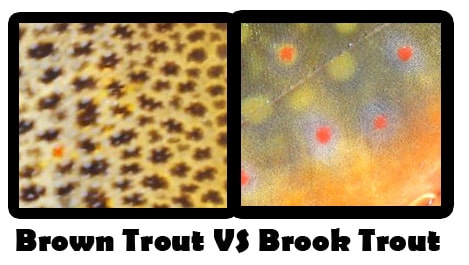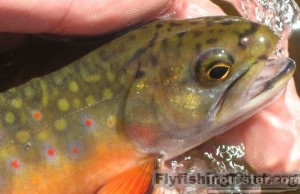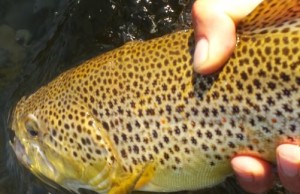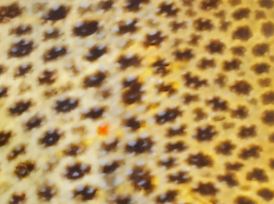This post was last updated on February 11th, 2023 at 05:55 pm
 There are many ways to easily identify brown trout vs brook trout. It’s very important to be able to easily distinguish between the two species because the minimum size allowed is very different for each of the trout species.
There are many ways to easily identify brown trout vs brook trout. It’s very important to be able to easily distinguish between the two species because the minimum size allowed is very different for each of the trout species.
Brookies (Salvelinus fontinalis) can be found in some of the same waters as brown trout, but very generally speaking, they don’t frequently inhabit the same areas. The reason for this is that brook trout prefer high elevation (above 5,000 feet) alpine rivers, lakes, and streams where the water is very cold year-round.
Brook trout are more often found in smaller pocket water streams and creeks, while browns are more often found in larger rivers and stillwater reservoirs and lakes.
Browns (Salmo trutta) are usually found at much lower altitude in water that’s a little warmer. They can also survive in water that’s well above 70F, while brook trout cannot.
Brook Trout vs Brown Trout – Differences Between the Brown and the Brook Trout
Using the table below you should immediately be able to tell the difference between brook trout vs brown trout based upon the pictures.
Species |
Brook Trout
(Salvelinus fontinalis)
|
Brown Trout
(Salmo trutta)
|
|---|---|---|
Average Size |
Between 6-10 inches total length | Between 8-18 inches total length |
Identification – Spots |
Pink spots with blue halos surrounding them.
|
Red and Black spots with white halos.
|
Body Coloration |
Back is grey-green with worm like markings. The belly of the brook trout will commonly have very vivid orange coloration. The Color intensity of the overall fish will become much more pronounced closer to spawning season in the fall. One of the most beautiful trout species | Back is brown, copper or orange with black spots. The belly of the brown trout is usually yellow to orange, but the orange is much less intense than that of the brook trout. The color of the brown trout can vary from almost silver (when found in lakes especially) to very vivid and pronounced colors close to the fall breeding season. The patterns are extremely variable. |
Habitat |
Mountain streams and smaller creeks and rivers. Can also be found in some lakes. They like riffle water but can be found anywhere in an average trout stream. Brook trout can successfully spawn in still water, and can cross breed (hybridize) with brown trout. | Any sized creek or river and commonly found in lakes. Preferred habitat will usually consist of deeper water with cover nearby. Brown trout cannot spawn in still water. Browns can hybridize with brookies, with the resulting fish being called “tiger” trout. |



